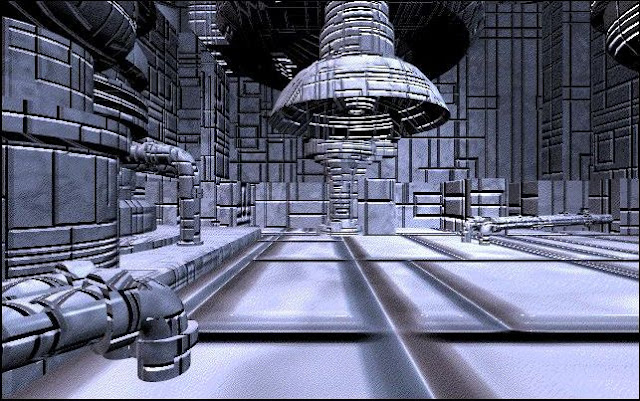L-ZONE --- A hyper-automated city built by a mad scientist.
Beneath a gigantic dome rise monumental buildings. Within them extend vast spaces.
The tense air throbs within the hum of machinery.
A realm chock-full of idling machines, yet not a soul stirs.
The moment the switch is thrown, L-ZONE awakes.
The whine of machinery...a robot starts to move...the flash of a nuclear explosion.
Pass down the corridors, open every door, evade each trap.
When you've gone through all the zones, the path to planet Green will show itself.
Activate the machines!
Solve L-ZONE's riddle!
Throw open the door to planet Green!
This is the introduction to L-ZONE, a rare and obscure adventure game made by Haruhiko Shono and Synergy in 1993. The game is so incredibly hard to find that I had to end up paying a good amount for my copy, as if it were a new game just released today. It was well worth it.
There is no real objective behind the introduction. You enter L-ZONE by way of pointing and clicking your way around it's environment. There are no enemies to kill, no missions, no story...you are entirely alone within L-ZONE, surrounded by a multitude of complex and intimidating machinery.
You'll make your way around the city much like a curious cat...wondering what happens if you push a button on a console or what machines still work. Many different areas lie ahead. There is a room full of giant speakers and effects modules, where pushing the right knobs will have you playing all kinds of synthetic sounds, like a futuristic heaven for an audiophile.
Eventually you'll come upon a room with an isolation tank. Enter the tank and prepare for one of the wildest trips of the game, straight out of the movie Altered States. If you haven't seen the movie, William Hurt plays a psychology professor who experiments with sensory-deprivation by using a floatation tank (an isolated tank filled with water). During a trip to Mexico he is given an intense form of Mushrooms by a tribe, and begins to shroom it up during his experiments. He experiences a form of biological devolution as a result, and you'll have to see the movie for all of it's trippy and psychedelic scenes. L-ZONE's isolation tank includes a trip of it's own, and it's a nice nod to the movie.
Many other surprises are in store within L-ZONE. Puzzles come in the form of the machines you discover. Pressing certain buttons will perform various actions. One room will feature a panel of levers for fusing matter. Others will reveal vague hints about future rooms. You'll also discover robots you can activate that can also reveal hints or open doors for you.
At one point, you won't be able to proceed until you find a special suit for the next area. Some puzzles will actually end the game right then and there, effectively killing your curiosities. But continue forging ahead, and eventually you'll discover the path to planet Green.
The best thing about experiencing L-ZONE is the whole ambiance the surroundings provide. This is where Shono's vision shines, and I was astounded by all the sights and sounds I was subjected to. You are going to feel completely alone within the rooms of these giant machines and their clicking, whirring and synthetic noises. All of the sound effects are amazing, including the techno-electronic music score by Norikazu Miura.
The graphics are equally astounding and I was constantly awestruck as I made my way around the domed city. For a game made 20 years ago they are still impressive, and many of the machines look like they could actually work.
My only problem with L-ZONE is that it is extremely short, and I was able to explore most of the environments and get to planet Green in less than an hour. I'm sure more time can be spent exploring L-ZONE's surroundings in a replay, or discovering the other "kill-switches" that are hidden within. But to understand the fact that Shono did most of the programming on the game himself is impressive to say the least.
It's a shame L-ZONE never received the recognition it deserved outside of Japan, and as a result it's become insanely obscure and hard to find. The game won many awards in Japan but almost disappeared entirely by the time Myst was released in the states that same year. This is a game that could benefit from an HD remake as well as an appearance on Steam or available as a download on current consoles.
Shono went on to develop other games, including the steampunk influenced visual novel Gadget, which also won awards in 1995. He also appeared as a conceptual artist for the 2004 film Casshern, and reappeared as an art director for Imabikisō, a visual novel for the PS3 and Wii that was never released outside of Japan.
To this day, L-ZONE remains a forgotten, lost masterpiece of a game...just waiting to be discovered by a new generation. And within L-ZONE lies a rich, futuristic world with timeless graphics and amazing ambiance. A treasure, indeed.
Here is some gameplay footage of L-ZONE, which gives you a good feel for it's unique atmosphere. Note that the player activates a "kill-switch" at the end of the video. That's not the end of the game, and I'm not sure if the player understands that or not!:

























I was already born during this era.
ReplyDeletebut thanks to you, I still discover some gems from the past.